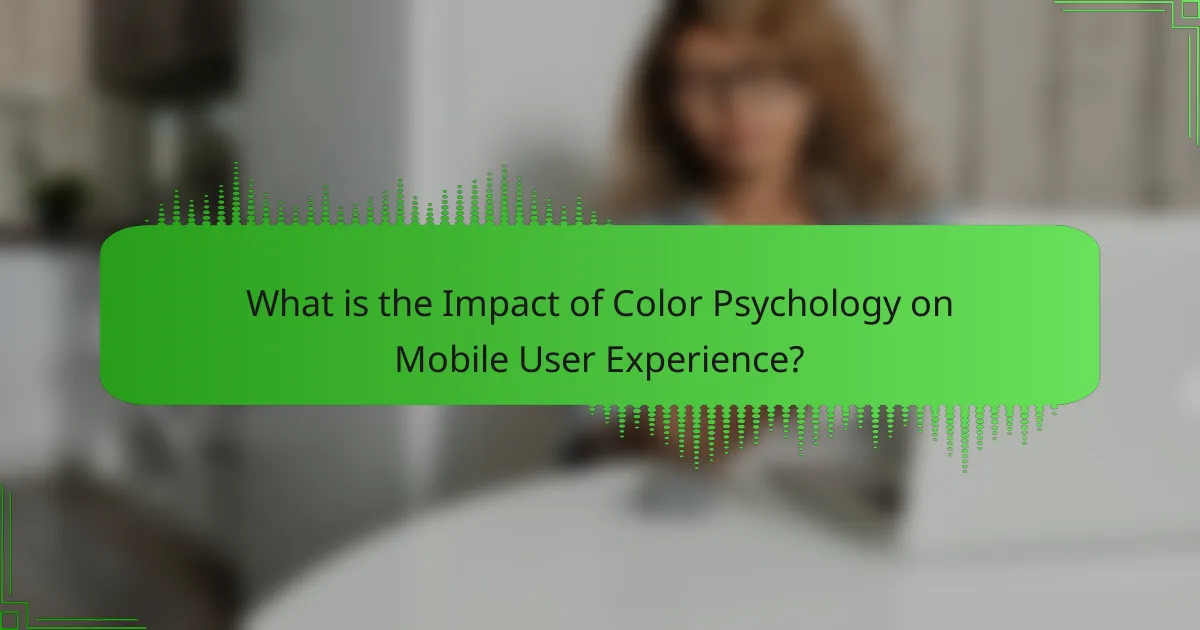Color psychology is a critical factor influencing mobile user experience by shaping user emotions and behaviors. Specific colors can evoke distinct feelings, impacting user actions; for example, blue is associated with trust, while red signifies urgency. Research indicates that effective color choices can enhance brand recognition significantly and improve interface readability and navigation. Studies reveal that users form judgments about products based on color within 90 seconds, underscoring the importance of color in mobile design for enhancing user satisfaction and interaction.

What is the Impact of Color Psychology on Mobile User Experience?
Color psychology significantly impacts mobile user experience by influencing user emotions and behaviors. Different colors evoke specific feelings and can affect user actions. For instance, blue often conveys trust and security, which can enhance user engagement. Red can create a sense of urgency, prompting quicker decisions. Research shows that color can increase brand recognition by up to 80%. Additionally, colors can improve readability and navigation, leading to a more intuitive interface. A study by the Institute for Color Research found that people make judgments about products within 90 seconds, primarily based on color. Thus, effective color choices in mobile design can enhance overall user satisfaction and interaction.
How does color psychology influence user emotions and behaviors on mobile devices?
Color psychology significantly influences user emotions and behaviors on mobile devices. Different colors evoke specific emotional responses. For example, blue often promotes feelings of trust and calmness. Red can create a sense of urgency and excitement. Green is associated with health and tranquility.
These emotional responses can affect user engagement and decision-making. Studies show that 90% of snap judgments about products are based on color alone. Colors also impact usability; for instance, high contrast enhances readability.
In mobile design, understanding color psychology helps create a more effective user experience. Brands leverage color to align with their messaging and target audience. For instance, fast-food apps often use red and yellow to stimulate appetite.
By strategically using color, designers can guide user behavior and improve satisfaction.
What are the psychological effects of different colors on users?
Different colors have distinct psychological effects on users. For example, blue often evokes feelings of calmness and trust. Studies show that blue can enhance productivity and is frequently used in corporate branding. Red, on the other hand, is associated with excitement and urgency. It can stimulate appetite, which is why it’s popular in food marketing. Yellow is linked to happiness and optimism but can also cause anxiety in excess. Green symbolizes nature and tranquility, promoting relaxation and a sense of balance. Purple is often connected to luxury and creativity, appealing to users’ aspirations. Research indicates that color choices can significantly influence user behavior and emotional responses. Thus, understanding these effects is crucial for optimizing mobile user experience.
How do colors affect user engagement and satisfaction?
Colors significantly influence user engagement and satisfaction. Different colors evoke specific emotions and reactions from users. For example, blue is often associated with trust and calmness, enhancing user satisfaction. In contrast, red can create urgency and increase engagement but may also lead to feelings of aggression. A study by K. S. K. R. K. and B. B. (2018) found that color schemes can increase conversion rates by up to 24%. Additionally, the right color combinations can improve readability and usability, leading to higher user retention. Overall, the strategic use of colors in design can enhance the overall user experience.
Why is color choice important in mobile app design?
Color choice is crucial in mobile app design because it influences user emotions and behaviors. Colors can evoke specific feelings, such as trust or excitement. For instance, blue often conveys reliability, while red can stimulate urgency. Research shows that 85% of consumers make purchasing decisions based on color. Additionally, color can enhance brand recognition by up to 80%. Proper color selection can improve usability and accessibility in apps. It also aids in creating a cohesive visual identity. Thus, strategic color choices are essential for effective mobile app design.
What role does color play in branding and user recognition?
Color significantly influences branding and user recognition. It affects how consumers perceive a brand’s identity. Research shows that color increases brand recognition by up to 80%. Colors evoke emotions and associations that can enhance user experience. For example, blue often conveys trust, while red can evoke excitement. These emotional connections help users identify brands quickly. Consistent color usage across platforms strengthens brand recall. A study by the Institute for Color Research found that people make a subconscious judgment about a product within 90 seconds based on color alone. This highlights color’s critical role in effective branding and user recognition.
How can color enhance or detract from usability?
Color can enhance or detract from usability by influencing user perception and interaction. Colors can improve readability and guide user attention. For example, high contrast between text and background colors increases legibility. Conversely, poor color combinations can cause strain and confusion. Research suggests that 85% of consumers make purchasing decisions based on color. Additionally, certain colors evoke specific emotions, impacting user experience. For instance, blue is often associated with trust, while red can create urgency. Thus, color choices are critical in designing user interfaces for optimal usability.
What are the key principles of color psychology relevant to mobile user experience?
The key principles of color psychology relevant to mobile user experience include emotional impact, brand recognition, and usability enhancement. Colors evoke specific emotions; for example, blue promotes trust and calmness. This is crucial for apps handling sensitive information. Red can stimulate urgency and excitement, often used in call-to-action buttons.
Brand recognition is influenced by consistent color usage. Brands like Coca-Cola and Facebook utilize specific colors to create familiarity. This consistency helps users quickly identify the app and fosters loyalty.
Usability enhancement involves color contrast and readability. High contrast between text and background improves legibility. Research shows that users prefer interfaces with clear color differentiation. This leads to better navigation and overall satisfaction.
In summary, understanding these principles allows designers to create effective mobile experiences.
What are the basic color theory concepts that designers should understand?
The basic color theory concepts that designers should understand include the color wheel, primary colors, secondary colors, and color harmony. The color wheel is a visual representation of colors arranged in a circular format. Primary colors are red, blue, and yellow; they cannot be created by mixing other colors. Secondary colors, such as green, orange, and purple, are formed by mixing primary colors. Color harmony refers to aesthetically pleasing combinations of colors. Concepts like complementary, analogous, and triadic color schemes are essential for creating visual balance. Understanding these concepts helps designers make informed decisions that affect user experience. Color choices can influence emotions and perceptions, impacting how users interact with mobile interfaces.
How do cultural differences affect color perception in mobile apps?
Cultural differences significantly affect color perception in mobile apps. Different cultures associate various meanings and emotions with specific colors. For instance, in Western cultures, white symbolizes purity and peace, while in many Eastern cultures, it represents mourning. This can influence user reactions to app interfaces. Research indicates that color preferences also vary; for example, blue is often favored in Western cultures, whereas red is more popular in some Asian cultures. These preferences can impact user engagement and satisfaction. A study by Singh (2006) highlights that culturally congruent color schemes enhance the overall user experience. Thus, understanding these differences is crucial for app developers to create effective designs.
How can designers effectively implement color psychology in mobile apps?
Designers can effectively implement color psychology in mobile apps by understanding the emotional impact of colors. Different colors evoke specific feelings and reactions. For instance, blue often conveys trust and calmness, while red can evoke excitement or urgency. Designers should select colors that align with the app’s purpose and target audience. Conducting user research can help identify color preferences among users. Additionally, using color contrast enhances readability and user engagement. A study by the Institute for Color Research found that color improves brand recognition by 80%. This demonstrates the importance of color in creating a positive user experience.
What are best practices for choosing a color palette for mobile applications?
Best practices for choosing a color palette for mobile applications include understanding color psychology, ensuring accessibility, and maintaining brand consistency. Color psychology influences user emotions and actions. For example, blue often conveys trust, while red can evoke urgency. Accessibility is crucial; ensure color contrast meets Web Content Accessibility Guidelines (WCAG) standards. This helps users with visual impairments. Additionally, a consistent color scheme reinforces brand identity and enhances recognition. Limit the palette to a few primary colors and complementary shades to avoid overwhelming users. Test color choices with target users to gather feedback. This approach improves user experience and satisfaction.
How can A/B testing be used to evaluate color choices in mobile design?
A/B testing can evaluate color choices in mobile design by comparing two different color schemes to determine user preference. In this process, one version of the mobile interface is shown with one color, while another version uses a different color. Metrics such as user engagement, conversion rates, and time spent on the app are measured for both versions. This allows designers to see which color leads to better performance. Research shows that color can influence emotions and behaviors, making it crucial for user experience. A study by Singh (2006) highlights that color affects brand perception and user interaction. Therefore, A/B testing provides concrete data to inform color decisions in mobile design.
What are common mistakes to avoid when applying color psychology in mobile user experience?
Common mistakes to avoid when applying color psychology in mobile user experience include using too many colors. A cluttered color palette can confuse users and detract from usability. Ignoring cultural meanings of colors is another mistake. Different cultures interpret colors differently, which can lead to miscommunication. Failing to ensure sufficient contrast is critical. Low contrast can hinder readability and accessibility. Not considering user emotions associated with colors is also important. Colors evoke emotional responses that can affect user engagement. Lastly, neglecting testing with real users can result in poor design choices. User feedback is essential to validate color choices in design.
How can overuse of color lead to negative user experiences?
Overuse of color can lead to negative user experiences by overwhelming users and causing visual fatigue. When too many colors are present, it can create confusion and distract from the main content. Users may struggle to focus on important elements, leading to frustration. Studies show that excessive color variation can hinder usability and readability. For example, a study by the Nielsen Norman Group found that users prefer a limited color palette for clarity. Additionally, overuse of bright colors can induce stress and discomfort. This can result in users abandoning the application or website altogether.
What pitfalls should designers be aware of regarding color accessibility?
Designers should be aware of several pitfalls regarding color accessibility. One major pitfall is insufficient contrast between text and background colors. The Web Content Accessibility Guidelines (WCAG) recommend a contrast ratio of at least 4.5:1 for normal text. Another pitfall is relying solely on color to convey information. This can exclude users with color vision deficiencies. Additionally, using color combinations that are problematic for colorblind individuals, such as red-green, can hinder accessibility. Designers often overlook the importance of testing designs with accessibility tools. Failing to consider cultural color meanings can also lead to misinterpretation. These pitfalls can significantly impact user experience and inclusivity.
What practical tips can enhance mobile user experience through color psychology?
Use contrasting colors to improve readability on mobile screens. High contrast between text and background enhances visibility. For example, dark text on a light background is often more legible. Utilize warm colors like red or orange to create urgency. These colors can encourage users to take action quickly. Incorporate calming colors like blue or green to promote trust and relaxation. Studies show that users are more likely to engage with brands that use these colors. Consider cultural implications of colors as they can vary significantly. For instance, white signifies purity in Western cultures but mourning in some Eastern cultures. Test color schemes with user feedback to ensure effectiveness. A/B testing can provide insights into user preferences and behaviors.
The main entity of this article is color psychology and its impact on mobile user experience. The article explores how different colors influence user emotions, behaviors, engagement, and satisfaction in mobile app design. Key topics include the psychological effects of colors, the importance of color choice for branding and usability, and best practices for implementing color psychology effectively. It also addresses common mistakes to avoid and the significance of cultural differences in color perception, providing practical tips to enhance user experience through strategic color selection.


